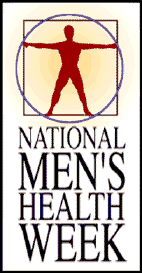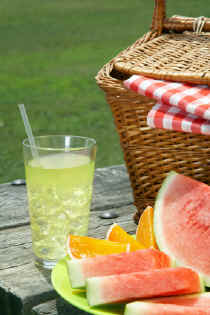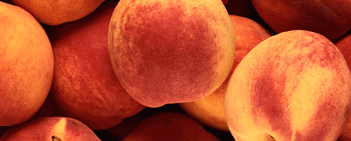Summer 2008: To Your Health
In this Issue:
- Celebrating National Men’s Health Week: June 12-18
- Nutrition Tips for Getting the Most from Strength Training
- Can Vitamins Help to Save My Vision?
- Healthy Summer Picnic Menu Ideas
- Nutritional Care for Breastfeeding Moms
- Avoid Exercise Burnout in the Summer Heat
- Feature Food of the Month: Peach
- Healthy Recipe: Peach Cobbler
Celebrating National Men’s Health Week: June 12-18

Established in 1994, National Men’s Health Week is aimed at encouraging prevention, early detection and treatment of disease for men and boys. It also alerts the media, policy makers, and health care providers to encourage men and boys to become more aware of their health by scheduling regular medical check-ups. Give the gift of health this Father’s Day to the man in your life by offering to take him to the doctor, plan a fitness activity you both will enjoy, or give him a gift certificate for a nutrition checkup to get him on the path to good health!
Gift Certificate! BRG Dietetics & Nutrition, P.C. is pleased to offer a free nutrition check up for the man in your life!
Contact Bonnie R. Giller, MS, RD, CDE, CDN for more information!
Nutrition Tips for Getting the Most from Strength Training

It is no surprise that proper nutrition and exercise are an important part of a healthy lifestyle, and that the foods and beverages we consume give us the energy we need to complete daily tasks. However, what we eat also plays an important role in exercise, both cardiovascular and strength training. It’s essential to include carbohydrates, fats, and protein to ensure that we sustain the energy required to physically complete cardiovascular exercise, as well as to build desired muscle and decrease body fat.
Carbohydrates: Carbohydrates play an important role in providing the energy required for muscular contractions. They are quickly digested into sugars (glucose, fructose, and galactose), absorbed by the body, and then are released as energy. Glucose that is not immediately needed is stored as glycogen in the muscles and liver. Glycogen is used as energy for any short bursts of intense exercise, such as sprints and weight lifting. If the body doesn’t have enough carbohydrate, protein is used for energy; however, this can limit one’s ability to build and maintain body tissues since protein is primarily responsible for building skin, hair, muscle and bone tissue. In essence, the body has to work harder if there is an inadequate intake of carbohydrate. Two types of carbohydrates are simple and complex. Simple carbohydrates (simple sugars) are converted to energy quickly and include energy drinks such as Gatorade. Complex carbohydrates take longer to be absorbed into the body and provide energy. They include bread, rice and pasta. For athletes, starch is also an important complex carbohydrate because it is broken down and stored as glycogen.
Fat: Fat is an essential nutrient for health and provides a cushion support for internal organs. Fat is also important to the body since it moves fat soluble vitamins (A, D, E, & K) throughout the body, and is our largest energy reserve for exercise and daily activities. One gram of fat equals nine calories and one pound of stored fat yields approximately 3,500 calories. Thus, it is the main fuel source for long duration and slow intensity activities (endurance sports) such as walking, cycling, and marathons. Fat digests slowly and converting it to energy that can be used by the muscles uses a lot of oxygen and can take up to 6 hours. Therefore, exercise intensity must be lowered for this to occur. Generally, it is best to avoid eating fat immediately before intense exercise. Unsaturated fat have health benefits such as lowering cholesterol and reducing the risk of heart disease, and sources include canola and olive oil, salmon, almonds, and soybeans. Saturated fats are linked to high cholesterol and heart disease and sources include meat, cheese, butter, milk, and egg yolks.
Protein: Protein consists of amino acids that are the building blocks of the body and help to make bones, skin, muscles and tendons. In addition, they aid in enzyme production and nutrient transport. Since protein isn’t easily stored in the body, it is essential to consume this nutrient daily. Protein is especially important to athletes and those who strength train regularly since protein helps to build and repair muscle that is broken down during exercise. The average adults requires 0.8 grams per kilogram of body weight per day, and for strength training and endurance athletes, this number can increase to anywhere from 1.2-1.4. Food sources of protein include animal meats such as turkey, chicken, and beef (3 oz. has 21 grams of protein), peanut butter, eggs, yogurt, and cheese.
Click here for pre-workout snack ideas!
Can Vitamins Help to Save My Vision?

Age-related macular degeneration (AMD) is the most common cause of blindness in people over the age of 65. This disease affects the part of the eye (the macula densa portion of the retina) that is responsible for acute vision, like reading and writing. A healthy macula is capable of seeing “20/20” (‘normal’) vision. The outer retina contains many polyunsaturated fatty acids that can easily become oxidized and begin deterioration. Over 10 million Americans suffer from AMD, with the numbers rising steadily by the year. Since AMD is so common, researchers are working on measures of prevention. Due to the high chance of oxidation in the retina, scientists have found that consuming certain antioxidants, such as the carotenoids lutein and zeaxanthin, can decrease the damage in the retina and protect against macular degeneration.
Lutein and zeaxanthin are two carotenoids found in our diet. From the many carotenoids in the diet, the retina accumulates only these two (zeaxanthin and lutein). Carotenoids are the most widespread group of naturally occurring pigments. They are responsible for the orange, yellow, and red color of fruit and vegetables, as well as dark leafy green vegetables. Eating 5 servings of fruits and vegetables a day, as recommended by the National Cancer Institute and the U.S.D.A, can provide approximately 6 mg of carotenoids, including lutein and zeaxanthin, given your choice of fruits and vegetables. Research has shown that consuming 6-10 mg of lutein and zeaxanthin per day reduces the risk for developing AMD.
Click here for information on how to include caroteinoids into your daily diet.
JULY IS NATIONAL EYE HEALTH MONTH
July is aimed at educating the public about early detection and treatment of eye conditions and diseases essential to maintaining good vision throughout life. Research reveals that a diet rich in antioxidants from fruits and vegetables can decrease the incidence of eye conditions and diseases. Contact Bonnie R. Giller, MS, RD, CDE, CDN for more information.
Healthy Summer Picnic Menu Ideas

July is National Picnic Month and it’s that time of year when families are eager to get outdoors and enjoy the sunshine, warm breezes, and of course…picnics! Whether you’re going to relax on the beach for lunch or gather with family and friends for a picnic dinner at the park, it’s the perfect time to experiment with healthy, creative and colorful menu ideas.
- Add chunks of apricots or peaches to turkey or chicken salad to add a burst of flavor.
- Assemble chicken kabobs with chicken strips, pineapple, onions, and colorful bell peppers for grilling.
- Add thinly-sliced turkey or chicken breast, low-fat cheese, lettuce, tomato and fresh herbs to focaccia bread. Swap the mayonnaise or mustard for a drizzle of olive oil and balsamic vinegar. You can even place this on the grill for a crispy crust and melted cheese.
- Add lemon juice and chopped garlic to cooled, boiled string beans and toss for a quick and easy side dish!
- Spruce up your pasta and potato salads by adding red, green, and/or yellow peppers along with some cherry tomatoes and cucumbers. All the colors are sure to get your guests’ attention!
- Add mango or papaya strips to a mesculine and baby spinach salad. Top with a raspberry vinaigrette dressing for added flavor.
- Add grilled chicken, vegetables (peppers, zucchini and yellow squash), and some pineapple chunks to grilled pita bread for a tropical spin on a healthy picnic pita!
- For a sweet and nutritious treat, whip up some popsicles by blending peach puree, pears or nectarines with 1 Tb. lemon juice. Pour into popsicle molds and freeze until firm.
- Add seltzer to 100% fruit juices for a fruit spritzer that both kids and adults will love!
- Add raspberry or cranberry juice to lemonade. Dilute sweet drinks with water since they may increase thirst, especially in the summer heat.
- Toss up a quick, healthy pasta salad with whole wheat pasta. Add cherry tomatoes, craisins, and walnuts for added color and crunch! Drizzle with a homemade honey Dijon dressing.
- Yogurt popsicles are a cool nutritious treat for everyone! Combine vanilla yogurt, crushed pineapple, and frozen pineapple orange juice in a blender. Place mixture into a cup or mold with popsicle sticks inserted. Freeze until firm and enjoy!
Visit our special web section for tips on picnic food safety.
Nutritional Care for Breastfeeding Moms:
World Breastfeeding Week is August 1-7, 2008

Developed by the World Alliance for Breastfeeding Action, World Breastfeeding Week is typically observed the first week of August every year and aims to spread information globally about the importance of breastfeeding for maternal and child health. Breastfeeding is encouraged for all women since it strengthens the newborn’s immune system and also creates a bonding experience between a mother and her baby. In addition, the hormones produced during lactation aid in the return of the cervix to its pre-pregnancy size. Here is some practical advice on achieving a balanced diet while breastfeeding to ensure that you and your baby are healthy.
Eat a variety of foods, including the following:
- Protein sources such as chicken, lean meat, eggs, and fish. Aim to consume fatty fish such as mackerel and salmon for an omega-3 fatty acid boost. It is recommended to limit fish to no more than 12 ounces per week, and limit albacore tuna fish to no more than 6 ounces per week while breastfeeding.
- Whole grain bread, pasta, rice, and cereal not only give you the energy you require to care for your newborn, but they also provide dietary fiber. Dietary fiber is necessary for intestinal and colon health and will benefit women who experience constipation after childbirth.
- Aim for five portions of fruits and vegetables daily. This includes fresh, frozen, dried or juice sources.
- Include low-fat dairy products in your diet to ensure you are receiving adequate calcium. This includes low-fat milk, cheese and yogurt which are also good sources of protein. If you are lactose intolerant, choose products that are lactose free such as Lactaid milk or soymilk.
- Aim for at least 8-9 glasses of fluid daily while breastfeeding. Oftentimes when you are thirsty, this means you are already dehydrated.
Foods to avoid while breastfeeding:
- Women who are nursing should avoid eating shark, swordfish, king mackerel, and tile fish as they have large levels of mercury and other environmental contaminants. Canned albacore tuna fish should be limited to 6 ounces per week (2 3-ounce servings), and no more than 12 ounces per week of most other fish.
- Since peanuts are the most common form of food allergy, it is best to avoid consuming peanuts and peanut products while breastfeeding if you or family members are allergic. In addition, it is recommended to avoid feeding peanut products to children who are considered high risk before age three.
- Limit your intake of caffeine and alcohol. Be cautious what you put into your body since this usually gets passed through to your newborn through your breast milk and will affect your baby.
Click here to learn more about the nutritional benefits of breast milk.
Avoid Exercise Burnout in the Summer Heat
While consistent exercising and healthy eating are essential to keeping fit, too much of a good thing can actually put your body in harms way. Here are some tips to help you avoid exercise burnout this summer:
- Keep in mind that the concept of “moderation” applies not only to nutrition, but also exercise. An exercise regimen that is started by working out too hard or too frequently is doomed for a burnout, leading you to quit all together.
- Begin your regimen slowly with 20 minute sessions. An effective workout consists of slowly increasing your exercise intensity and frequency safely each week.
- Trade a few gym days by working out at home. Other low-impact activities that can still provide health benefits include brisk walking, cycling, rollerblading, and even gardening.
- Alter your exercise routine every 4 weeks to keep your muscles up to speed. This is crucial to getting the results you desire.
- Listen to your body. Loss of appetite, recurring injury and extreme fatigue are signs of overtraining and signals that your body needs a rest.
- Alternate between 2-3 cardio machines such as the treadmill, bicycle, and elliptical in one workout. Aim for 10-15 minutes on each machine for a total of 30 minutes.
- Vary your workout weekly by incorporating a higher intensity, higher reps, heavier weights, or a completely new exercise move.
- Allow for at least 1 day of light activity or rest each week.
- Keep your body well hydrated, especially if exercising outdoors or in a pool.
Feature Food of the Month: Peaches

A member of the rose family, the peach has origins in China and was often viewed as a symbol of longevity. Transportation of the peach plant to America was around the time of the American Revolution, and the simplest way to do so was to propagate by seed. Peaches are typically available year round, and the season dictates the variety that can include semi-freestone peaches (April-June) and freestone or clingstone peaches (mid-June). Half of the United States crop comes from California, and the other half from the south. Typically off-season peaches are imported from Mexico or Chile. The flesh of the peach usually varies in colors from light yellow to orange-red, and the fruit inside is typically yellow or white.
When selecting fresh peaches, it’s important to choose ones that are fragrant, semi-soft and blemish free. Since peaches vary in color due to the variety, often times color is not a sign of how the fruit will taste. Peaches can be ripened at home by placing them in a brown paper bag at room temperature for 2-3 days. They are highly perishable so consider how many you will consume in your household at a given time when purchasing. Peaches can be stored in a dim, cool area or in the refrigerator for up to 5 days. If you purchase canned peaches, ensure they are canned in their own juice and not in heavy syrup, since this can add significant calories and sugar.
Nutritionally, peaches are a good source of vitamins A and C and are free of cholesterol, fat and sodium in their natural state. Add peaches to cereal, yogurt, smoothies, over angel food cake, or even grill them on the barbeque with your favorite meat or fish dishes!
Healthy Recipe – Peach Cobbler
Ingredients:
6 medium peaches, sliced
6 1/3 tbsp. Splenda
1 tbsp. cornstarch
1 tsp. fresh lemon juice
½ tsp. ground cinnamon
1 cup all-purpose flour
1 ½ tsp. baking powder
½ tsp. table salt
3 tbsp. light margarine
½ cup nonfat milk
Instructions:
- Preheat oven to 375 degrees.
- In a large saucepan, combine peaches, 5 1/3 tablespoons Splenda, cornstarch, lemon juice and cinnamon; toss to coat peaches.
- Bring to a boil over medium heat. Cook until mixture thickens, about 1 minute.
- Remove from heat and transfer mixture to an 8-inch square baking pan.
- In a separate bowl, combine flour, remaining tablespoon of Splenda, baking powder and salt. Work in margarine with a fork until mixture resembles course crumbs.
- Add milk and stir until flour mixture is evenly moistened.
- Sprinkle topping mixture over peach mixture.
- Bake until topping is golden brown and filling is bubbly, about 20-25 minutes.
Yield: 8 servings
Serving Size: 1 piece
Exchanges: 1 Starch, 1 Fruit
Nutrition Facts:
Calories = 127
Total Fat = 2 grams
Saturated Fat = 0 gram
Cholesterol = 0 milligrams
Protein = 3 gram
Carbohydrate = 26 grams
Sodium = 451 milligrams
Dietary Fiber = 2 grams
For more healthy recipes, click here.

Leave a Reply
Want to join the discussion?Feel free to contribute!